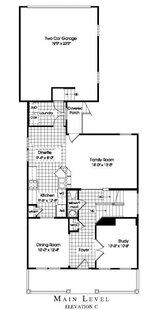Crashmph
Member
I am looking to set up my new shop in my new house this fall. I am seeking advice about the electrical situation and how I should proceed.
I will have the following tools in my new shop:
I realize that I need an electrician to do this for me, but I am just getting feelers out for information on what others have done so that I can make an informed decision. Thanks for you input.
UPDATES:
The Garage is attached to the house on the rear of the house. I have attached a picture clarification. My wife will be parking on the non-window side and my shop will be the windowed side. Windows in the garage were the best $600 upgrade in the entire house! Slight change to the picture, the steps down in the garage are not down to the windowed wall. They go the other way to the wife's parking spot.
I guess on further review you guys I would only need three 220v breakers (one for the DC, one for the air compressor for when it pseudo randomly kicks on, and one for the the other 220v tools) and half a dozen or so 110v breakers (one for the 10 4' shop lights, two for the center of the shop, and the other 3 or 4 along the walls). Tell me if I am wrong here... but those are my plans.
I will have the following tools in my new shop:
- ShopFox 3hp dust collector 220v
- SawStop table saw 3HP 220v
- Jet floor stand drill press 110/220v (would like to run at 220V)
- 6" Craftsman Jointer 110/220v (would like to run at 220V)
- (future) upright 2hp air compressor 220v (forgot to add this one)
- (future) Jet 1642 2HP 220v
- 13" Rigid Planer 110v
- 10" Ryobi compound slide miter 110v
- Rikon Midi lathe 110v
- Delta/Milwaukee 14" bandsaw 110v
- Jet Benchtop Spindle sander 110v
- Rikon 6x48 belt/10" disc sander 110v
I realize that I need an electrician to do this for me, but I am just getting feelers out for information on what others have done so that I can make an informed decision. Thanks for you input.
UPDATES:
The Garage is attached to the house on the rear of the house. I have attached a picture clarification. My wife will be parking on the non-window side and my shop will be the windowed side. Windows in the garage were the best $600 upgrade in the entire house! Slight change to the picture, the steps down in the garage are not down to the windowed wall. They go the other way to the wife's parking spot.
I guess on further review you guys I would only need three 220v breakers (one for the DC, one for the air compressor for when it pseudo randomly kicks on, and one for the the other 220v tools) and half a dozen or so 110v breakers (one for the 10 4' shop lights, two for the center of the shop, and the other 3 or 4 along the walls). Tell me if I am wrong here... but those are my plans.
Attachments
Last edited:

